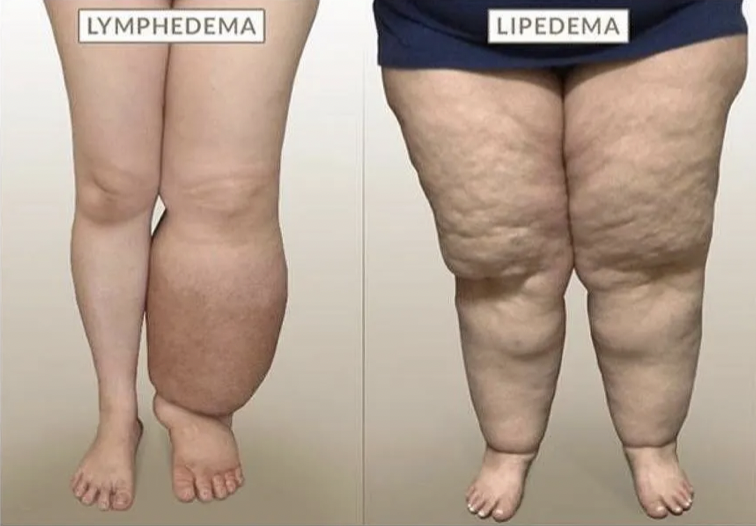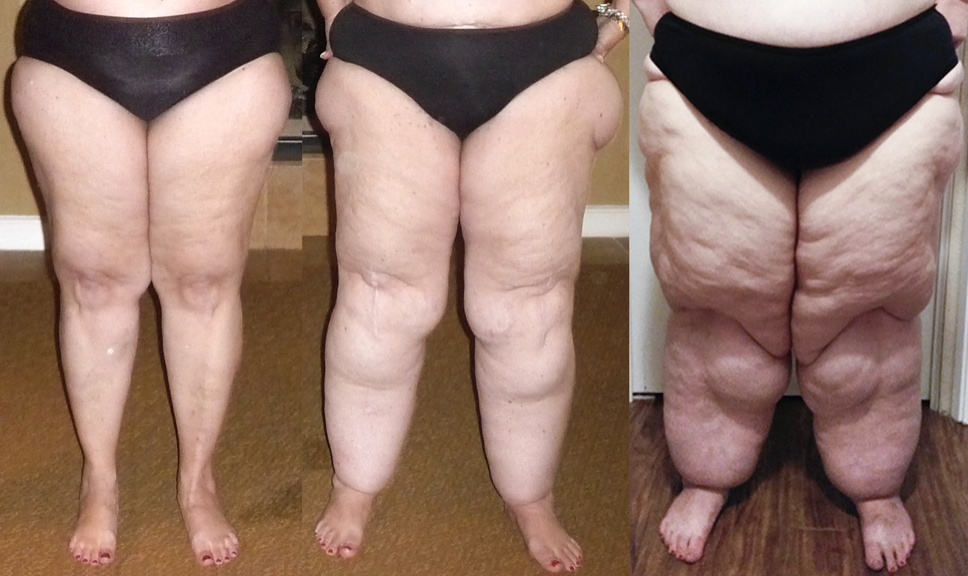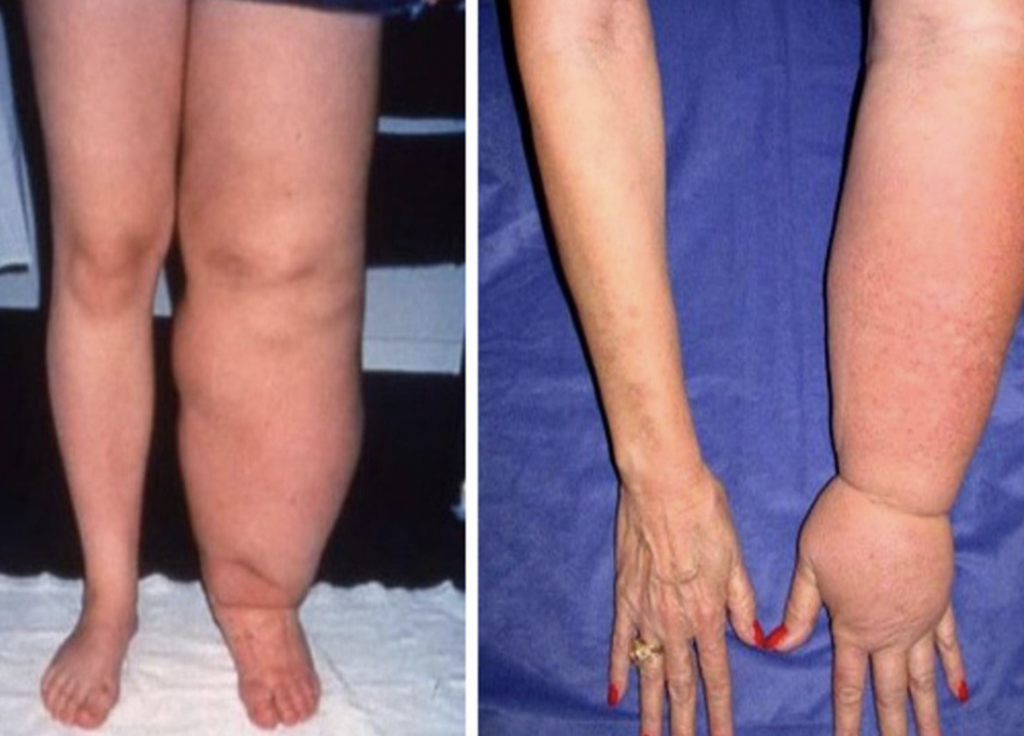The Lipedema vs Lymphedema debate is a tricky one, mainly due to the fact that there’s so much overlap between the two conditions. They both affect the lymphatic system, but in different ways. There are lots of similarities between the two, but there also are distinct differences that set them apart. Unfortunately, one regularly gets confused for another.
This is particularly common for women with Lipedema, medical staff often try to convince us that our symptoms are the result of Lymphedema not Lipedema. My doctor tried to palm me off in my initial appointment claiming it could be Lymphedema when I knew my symptoms all pointed to Lipedema. Even though Lipedema is thought to affect around 11% of women, there is still so little awareness.
What is Lipedema?
Lipedema (or Lipoedema) is a progressive condition that occurs almost exclusively in women. It manifests as symmetrical buildup of painful fat and swelling primarily in the legs, bum and sometimes arms, sparing the hands and feet. In the earlier stages, it causes a clear disproportion between the upper and lower body. Other symptoms include: bruising easily, heaviness, excess cellulite and swelling. Age of onset varies for each patient but it often begins during puberty, pregnancy, or menopause. Lipedema is regularly misdiagnosed as obesity, Lymphedema or cellulite.
What is Lymphedema?
Lymphedema (or Lymphoedema) is a chronic condition usually caused by a blockage in the lymphatic system, resulting in swelling in the body’s tissues. Any part of the body can be affected, but it normally develops in the arms and legs. Some of the symptoms of Lymphedema include: aching, heaviness, skin changes and infections as well as difficulty moving the limbs that are affected. The condition is often a result of damage to the lymphatic system, such as surgery or radiation therapy for cancer, alternatively it can be a congenital condition.
The differences in Lipedema vs Lymphedema
One of the main distinguishing symptoms in Lipedema vs Lymphedema is the symmetrical buildup of fat and swelling in Lipedema sufferers, compared to a lack of symmetry in the fluid buildup for people with Lymphedema. In short, Lymphedema can present itself in one arm or leg and not the other. Lymphedema also affects both men and women, whereas Lipedema is almost exclusively present in women.
The causes of each condition are completely unique too. The exact cause of Lipedema is unknown. However, hormonal changes, genetics, and inflammation are thought to play a role in its development. Lipedema is often hereditary, and it is more common in women who have a family history of the condition.
However, Lymphedema is usually not hereditary and develops circumstantially. It can be caused by surgery, radiation therapy to treat cancer sufferers or an injury that damages the lymphatic system. In some cases it can also be a congenital condition, this is when the lymphatic system fails to develop meaning it cannot drain lymph fluid properly in the body.
Lipedema Characteristics
• Swelling of the lower limbs, and sometimes arms, which is symmetrical
• General body shape is usually disproportionate
• The swelling is usually soft and often comprises of loose, floppy, connective tissue and fat
• There’s often a pad of fat just under and next to the knees and hips
• Feet or hands are not affected
• Firm pressure on the skin leaves obvious indentations
• Pain in the joints, especially the knees
• Tenderness of the tissues
• Limbs will often bruise easily
• Affects females only
• Diet and exercise will not improve the affected areas
• There is often a family history of the condition
Lymphedema Characteristics
• Swelling may be unequal on each side of the body
• Feet are frequently affected
• Pressure on the skin will leave an indent, especially in the early stages of the condition
• No pain is felt if pressure is applied to the skin, but tissues will feel tight
• Limbs do not bruise easily
• Increased risk of infection (cellulitis)
• Can affect females and males of any age
• The affected skin is often thickened
• Losing weight usually has a beneficial effect on the swelling
• There’s not usually a family history of the condition
Lack of awareness around Lipedema vs Lymphedema
When I got my Lipedema diagnosis at the end of last year, I found the biggest hurdle to overcome was convincing my doctor that I didn’t have Lymphedema. Because Lymphedema is a lot more recognised than Lipedema (especially in the UK) it can be a struggle to get through to medical staff.
You can read all about my Lipedema diagnosis in my blog ‘How to get a Lipedema diagnosis’. The best advice I can give is to make sure you go to your doctors appointment prepared with lots of research as to why you’re sure you have Lipedema, not Lymphedema. In most cases, you will be referred to a Lymphedema or vascular specialist who will know the distinct differences between the two conditions.
Has your Lipedema ever been misdiagnosed as Lymphedema? Send me an email at sophie@lipedemaandme.com and let me know.
Disclaimer: My blogs talk about Lipedema, diet, surgery and much more. I’m talking from my point of view to help women, and remind them they are not alone. I am not a medical professional, so the content above is from my own perspective with research I have done into the topic. It’s not meant as medical advice, you should always consult your doctor or a specialist for both your diagnosis, and a treatment plan.



